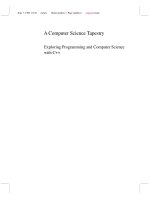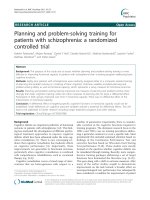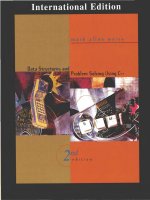programming and problem solving with c++ 6th by dale ch07
Bạn đang xem bản rút gọn của tài liệu. Xem và tải ngay bản đầy đủ của tài liệu tại đây (1.56 MB, 58 trang )
Chapter 7
Additional Control
Structures
Chapter 7 Topics
●
●
●
●
Switch Statement for Multi-Way Branching
Do-While Statement for Looping
For Statement for Looping
Using break and continue Statements
Chapter 7 Topics
●
●
●
Additional C++ Operators
Operator Precedence
Type Coercion in Arithmetic and Relational
Precedence
Switch Statement
The Switch statement is a selection control
structure for multi-way branching
switch
(IntegralExpression)
{
case
case
Constant1 :
Statement(s);
Constant2 :
Statement(s);
// optional
// optional
.
.
.
default :
Statement(s);
}
// optional
// optional
Example of Switch Statement
float
weightInPounds = 165.8;
char
weightUnit;
// User enters letter for desired weightUnit
. .
.
switch (weightUnit)
{
case ‘P’ :
case ‘p’ :
cout << weightInPounds << “ pounds “ << endl;
break;
case ‘O’ :
case ‘o’ :
cout << 16.0 * weightInPounds
<< “ ounces “ << endl;
Example of Switch Statement, continued
break;
case ‘G’ :
case ‘g’ :
cout << 454.0 * weightInPounds
<< “ grams “ << endl;
break;
default :
cout << “That unit is not handled! “ <<
endl;
break;
}
Switch Statement
●
●
●
The value of IntegralExpression (of
char, short, int, long or enum
type) determines which branch is
executed
Case labels are constant (possibly
named) integral expressions
Several case labels can precede a
statement
Control in Switch Statement
●
●
Control branches to the statement
following the case label that
matches the value of
IntegralExpression
Control proceeds through all
remaining statements, including the
default, unless redirected with
break
Control in Switch Statement
●
●
●
If no case label matches the value of
IntegralExpression, control branches
to the default label, if present
Otherwise control passes to the
statement following the entire switch
statement
Forgetting to use break can cause
logical errors because after a branch
is taken, control proceeds
sequentially until either break or the
end of the switch statement occurs
Do-While Statement
Do-While is a looping control structure
in which the loop condition is tested
after each iteration of the loop
SYNTAX
do
{
Statement
}
while (Expression);
Loop body statement can be a single statement or
a block
Example of Do-While
void GetYesOrNo (/* out */ char& response)
// Inputs a character from the user
// Postcondition: response has been input
//
&& response == ‘y’ or ‘n’
{
do
{
cin >> response;
// Skips leading whitespace
if ((response != ‘y’) && (response != ‘n’))
cout << “Please type y or n : “;
} while ((response != ‘y’) && (response != ‘n’));
}
Do-While Loop vs. While Loop
●
●
●
POST-TEST loop
(exit-condition)
The looping
condition is
tested after
executing the loop
body
Loop body is
always executed at
least once
●
●
●
PRE-TEST loop
(entry-condition)
The looping
condition is
tested before
executing the loop
body
Loop body may not
be executed at all
Do-While Loop
DO
Statement
WHILE
Expression
TRUE
FALSE
When the expression is tested and found to be
false, the loop is exited and control passes to
the statement that follows the Do-while statement
For Loop
SYNTAX
for (initialization; test expression;
update)
{
Zero or more statements to repeat
}
For Loop
For loop contains
● An initialization
●
An expression to test for
continuing
●
An update to execute after each
iteration of the body
Example of For Loop
int
num;
for (num = 1; num <= 3; num++)
{
cout << num << “Potato”
<< endl;
}
num
Example of Repetition
?
int
num;
for (num = 1; num <= 3; num++)
cout << num << “Potato”
<< endl;
OUTPUT
num
Example of Repetition
1
int
num;
for (num = 1; num <= 3; num++)
cout << num << “Potato”
<< endl;
OUTPUT
Example of Repetition
1
num
int
num;
true
for(num = 1; num <= 3; num++)
cout
<<
<<
num <<
endl;
“Potato”
OUTPUT
num
Example of Repetition
1
int
num;
for (num = 1; num <= 3; num++)
cout
<<
<<
num <<
endl;
“Potato”
OUTPUT
1Potato
num
Example of Repetition
2
int
num;
for (num = 1; num <= 3; num++)
cout
<<
<<
num <<
endl;
“Potato”
OUTPUT
1Potato
Example of Repetition
2
num
int
num;
true
for(num = 1; num <= 3; num++)
cout
<<
<<
num <<
endl;
“Potato”
OUTPUT
1Potato
Example of Repetition
2
num
int
num;
for (num = 1; num <= 3; num++)
cout
<<
<<
num <<
endl;
“Potato”
OUTPUT
1Potato
2Potato
num
Example of Repetition
3
int
num;
for (num = 1; num <= 3; num++)
cout
<<
<<
num <<
endl;
“Potato”
OUTPUT
1Potato
2Potato
Example of Repetition
3
num
int
num;
true
for(num = 1; num <= 3; num++)
cout
<<
<<
num <<
endl;
“Potato”
OUTPUT
1Potato
2Potato









